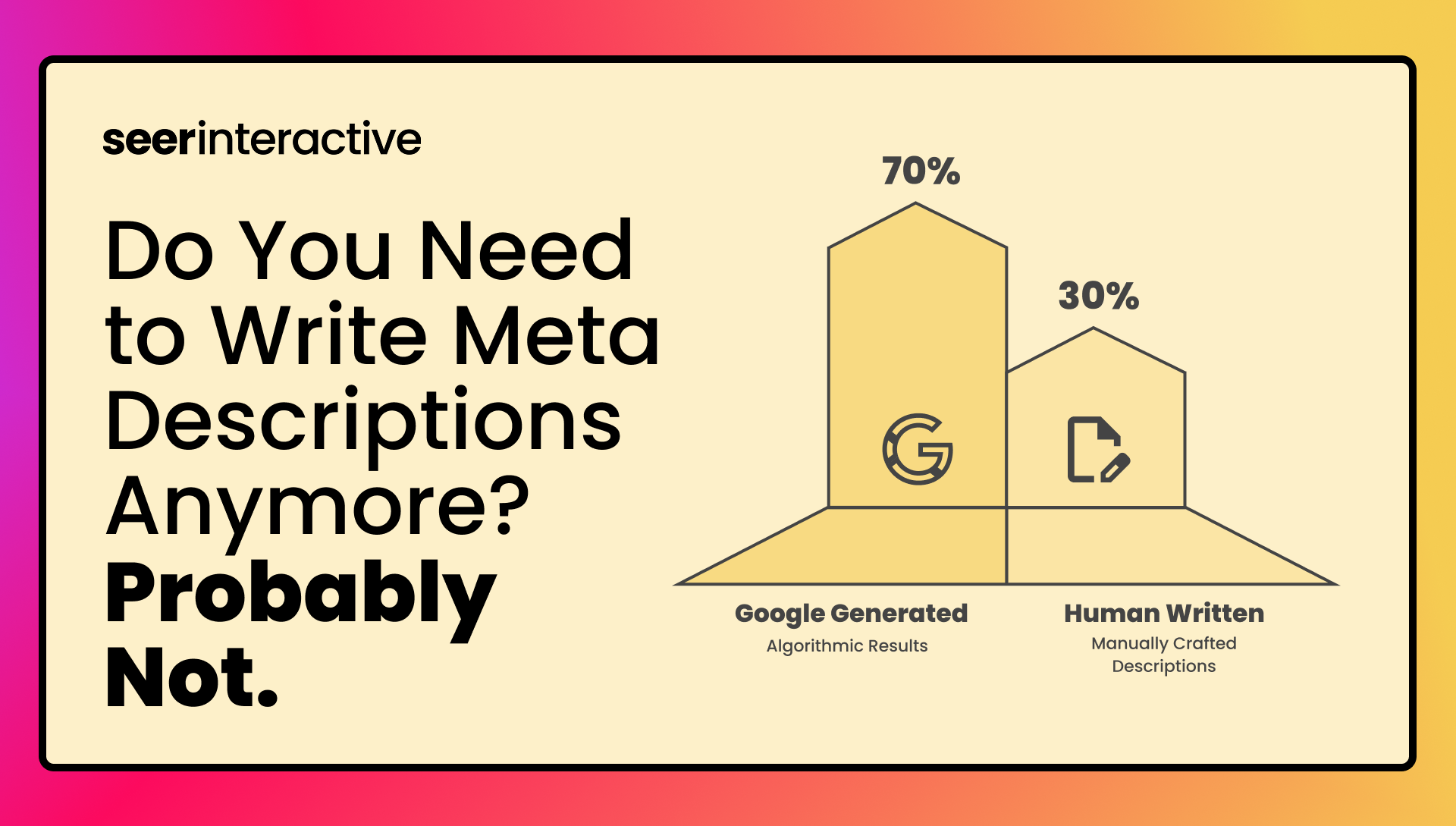The problem with communicating the value of SEO is that unless you're a subject matter expert, understanding how your marketing agency or in-house SEO team is driving a positive ROI can be a challenge. SEO can feel like a black box, and it can be hard to understand exactly what’s going on inside that black box.
SEO is part art and part science, and there’s no cookie cutter prescription for how to increase visibility within search engines for every website. SEO is also inherently different than PPC, in that it’s more geared towards long term vs. short term ROI. If you’re investing in SEO, you’re not paying a fee and seeing a return each time a user clicks on an ad or listing. You’re “buying” visits to your website in a much different way. It’s easier to understand your return on PPC ad spend (4:1 for example - i.e. I gave my PPC team $1 and they made me $4) then it is to understand how a $10k/month SEO retainer increased keywords and thus...had a positive ROI?
This creates the challenge of how to explain the ROI of an SEO investment to executives or the higher ups in the room who have no tangible understanding of SEO strategies and tactics. What’s the business impact of increasing keyword rankings? What’s the value of driving more traffic to a website? What’s the value of increasing the number of website conversions? I’ve been in the room with the CEOs of Fortune 500 companies who spend less than 1% of their working hours thinking about their websites, let alone channel-specific strategies and tactics aimed at increasing the visibility and traffic to their sites.
To be effective SEO practitioners, it’s essential that we not only execute our strategies and tactics, but that we can tie our channel-specific strategies and tactics back to business challenges, brand challenges, and strategic objectives. In other words, we need to be able to speak the language of those C-suite folks who control the SEO budget. We need to be able to explain how our channel-specific wins impact their business.
How To Explain The Value of SEO To Executives
Step 1: Put on Your Detective Hat
The first step in explaining the value of SEO to Executives is to uncover their challenges and goals, so that you can frame what you’re working on within the SEO channel through the lens of those challenges/goals. In other words, you have to understand what they care about. To do this, put on your detective hat, and ask a few pointed questions.
Below are questions aimed at understanding business challenges, brand challenges, and strategic objectives:
Business Challenge Questions
- What were the company’s targets last year, and what are they this year? Did you hit them last year?
- What do you report to the board?
- What are products/regions that lose money?
- Are there any new offerings coming down the pike?
- Is there any brand/product cannibalization?
- Any retention issues?
- How is your app engagement/utilization?
Brand Challenge Questions
- How do you measure brand health?
- What have the CMO and CEO been promising the market?
- How are you connecting brand activation to products?
- Are you targeting the right audience?
Strategic Objectives
- What are your strategic objectives?
- Retention/repeat sale?
- Increase average order size/quantity?
- Acquisition?
- Do you need new customer relationships?
- What do you think will be key for your company to achieve success this year?
- What can prevent you from reaching your goals?
- What are your revenue or other goals for the above?
I’ve found that it’s best to ask these questions at the beginning of an engagement, as they will help define your channel-specific (SEO in this case) strategy.
Step 2: Build Out an Organizational Matrix
Now that you know what the executives care about, it’s time to build an organizational matrix, which will outline key stakeholders. The trick is to then figure out what each person within the matrix cares about, so you can “speak their language” when it comes time to highlight the value of SEO. Don’t take that detective hat off yet!
We built a worksheet that will help you with your organizational chart, as well as the sections that follow.
Click here to access the worksheet, and see "Section 1: Organizational Chart". We populated the worksheet with some information about a company in San Diego to help give it some context! When you run through this exercise, make sure to clear out the populated cells.
Click to download the worksheet
Step 3: Define Your Full-Funnel Strategy
In order to understand how SEO fits into the greater marketing mix, we recommend figuring out which channels your client is already investing in throughout each stage of the funnel, and what their main strategic initiative is at each stage in the funnel. See the image below as an example (note that if a cell is blank they are not investing there -- don’t mind the colors).

Once you’ve wrapped your head around the above, you’ll be able to address the client’s brand, business, and strategic objectives within the most appropriate stages of the funnel, and prioritize where SEO should slot in accordingly.
Use the worksheet - Section 2: Marketing Funnel above for this stage in the process!
Step 4: Define your SEO Tactics
Once you know where throughout the funnel you think your client should invest time and money, now it’s time to outline your SEO channel-specific tactics that you think will help them reach their business objectives, and solve their brand, business, and strategic challenges.
For example, if your client wants to increase their loyal customer base to drive repeat sales [business challenge], you might suggest that your client create a landing page on their site that highlights their rewards program, so that it ranks in Google for all [client name] [rewards] keywords, which the site is not ranking for currently.
Use the worksheet - Section 3: SEO Specific Tactics For Marketing Strategy above for this stage in the process!
Step 5: Putting It All Together
Flash forward 12 months. Now that you’ve address various stages of the funnel through SEO tactics, it’s time to communicate the value of your efforts to those executives! I recommend doing this by taking a channel-specific KPI (increased keyword rankings, increased site traffic, increased site conversions, etc.), and then communicating that KPI through the lens of the business, brand, and strategic challenges that we outlined in Section 1.
For example:
Brand challenge: The CMO promised the market a quality product, but recently the company has received negative reviews because of a production error that caused faulty units. This resulted in negative press, which is hurting the brand.
Outcome of what the SEO team did: The SEO team improved [client’s] brand health by decreasing the amount of visible negative press on search engines. That visible negative press represented 2 million impressions/month within search engines. After looking at the data, we estimate that visible negative press impressions within search engines have decreased by 50% since our efforts began.
We did this by updating key pages of the website, which increased their visibility and decreased the visibility of other website pages with negative press. We also reached out to other websites that had previously featured negative product reviews, and had them updated. See appendix for a step-by-step breakdown of our efforts, and resulting KPI performance.
Notice how above, we’re addressing the brand challenge and then tying our channel-specific tactic to that brand challenge. Nowhere did we mention keyword rankings. That’s the key -- make a tangible connection between what you did within your marketing channel and the major goals/challenges that executives care about.
Use the worksheet - Section 4: Communicating Your Value above for this stage in the process!
Conclusion
Communicating the value of SEO to executives can be a challenge, especially if those executives are not well versed in the channel. Talking about SEO success through the lens of keyword rankings, website traffic, and conversions sounds great to subject matter experts, but if the folks paying your bills don’t fully understand the value of their investment, those marketing dollars might go elsewhere. By connecting what you’re doing to the things that executives really care about through the framework in this post, it’s my hope that your work will move its way up the value pyramid of your client’s organizations, and that executives will have zero ambiguity when asking "what’s the value of SEO?"
Interested in seeing what a valuable SEO strategy could look like for your business? Get in touch with us today.


